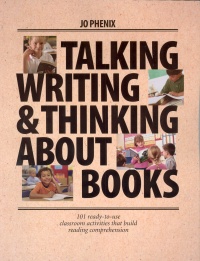| ________________
CM . . .
. Volume XII Number 18 . . . .May 12, 2006
excerpt:
In these days of increased daily physical activity, especially in grades 3-8 classrooms, this book provides 101 exercises (activities) to engage even the most reluctant participant in all aspects of the reading process. Right from the first line of the Introduction, Jo Phenix, a workshop leader and consultant who has taught every elementary and high school grade, sets the pace (parameters): “Every activity in this book starts with reading.” She then continues by describing the equipment (resources) used: novels, short stories, picture books, poems, scripts, magazines, newspaper articles, films, videos, television and advertisements. Then follows the form of participation: individually, in a small group, or with the whole class. Finally, the goal is in sight: “The goal of the activities is to enhance comprehension.” In order to score (demonstrate comprehension), a participant (reader) must be able to apply information from a text to new situations, either real or imaginary. The author suggests many ways of achieving this goal: by rereading parts of the text, skimming for specific information, rehearsing and presenting an oral reading, or reworking the text in a different format. It is in working through the exercises (activities) that they will be asked to go beyond the informational levels of reading, to reflect on what they have read, to analyze and interpret, to make judgements and comparisons. They will be asked to use their imaginations to hypothesize, predict, expand on the text, generate new ideas....They will learn...that a reader identifies with characters, wonders about motivations, senses mood, predicts possible outcomes, imagines settings and scenarios, develops tastes. This is the long-lasting learning they need to become fluent readers.The 101 ready-to-copy activities are arranged in five chapters geared to the mode of response. Each category has a different focus: Talking/Reading Aloud - character, plot, personal responseThe title page for each chapter has a short introduction to the language arts component and lists the activities that follow. Writing and Visual Arts have the most activities. My favourite activities include: Oral Language - a character giving a speech, writing a song about events in the story. The Introduction to the book includes an index chart organized by chapter detailing the kind of activity, reflection focus and the page number for individual, partner, or group activities. There is also a two page spread on how to use the activities (choosing, groupings, organizing), and a reproducible Activity Log for students to keep their own record of completed activities. Highly Recommended. Gina Varty, a teacher-librarian in Edmonton, AB, currently provides library supply for Edmonton Public Schools.
To comment
on this title or this review, send mail to cm@umanitoba.ca.
Copyright © the Manitoba Library Association. Reproduction for personal
use is permitted only if this copyright notice is maintained. Any
other reproduction is prohibited without permission.
NEXT REVIEW |
TABLE OF CONTENTS FOR THIS ISSUE
- May 12, 2006.
AUTHORS |
TITLES |
MEDIA REVIEWS |
PROFILES |
BACK ISSUES |
SEARCH |
CMARCHIVE |
HOME |
